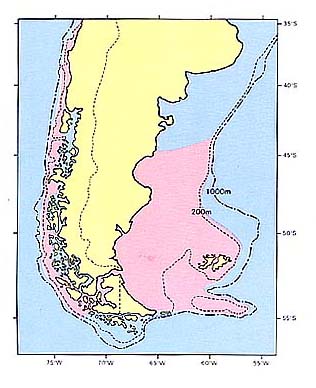ジンドウイカ科
- HOME
- デジタル図鑑
- パタゴニア海域の重要水族
- 軟体動物門 頭足綱 ツツイカ目
- ジンドウイカ科
ジンドウイカ科(Loliginidae)

Female
Large male
144 パタゴニアヤリイカ(Patagonia-yariika)
Loligo gahiD´Orbigny, 1835
Calamarete (Arg.), Calamar (Ch.), Patagonian squid (En.)
特 徴:
体はむしろ細長く,外形はアメリカケンサキイカ(Loligo pealei)に似ている。ただし,雄の大型個体(写真下段)は特に細長く,いわゆるDoryteuthis型となる。鰭は菱形で細長く,長さは背外套長の50~53%,幅は雌と背外套長20cm以下の雄では47~50%,20cm以上の雄では37~44%。鰭頂角は30°~43°。頭部は外套部よりも細く,頭幅は背外套長の11~17%。漏斗と外套膜をつなぐ軟骨器は単純な?型。眼は表皮と連続する透明な膜でおおわれる閉眼型。腕の長さは,第Ⅱ,Ⅲ,Ⅳ腕がほぼ等しく,第?腕が最も短い。各腕の吸盤は2列で,吸盤の角質環には5~9本の板状歯があるが,基部側の半円は平滑。雄の左第?腕は交接腕となり,先端部1/3~1/4の吸盤基部は肥大して2列のうね状に並び,背側の一列の吸盤は微小かあるいはない。触腕はむしろ短く,ホルマリン固定の標本では背外套長よりも短い。掌部も小さく,その長さは背外套長の17~21%(写真下段の標本は掌部が再生しつつあるものと思われ,触腕は著しく短い)。掌部の吸盤は4列で,中央の2列が肥大しているが,両側の2列のものは小さい。最大吸盤の角質環には32~38本の鈍い小歯が基部を接して並ぶ。体色は紫色を帯びた褐色で,ホルマリン固定標本では雄の大型個体の腹正中線に暗色の帯がある。本水域に分布する他の1種L. sanpaulensisとは,鰭の相対的な長さと幅,触腕の長さ,掌部の大きさと吸盤角質環の形状などによって区別される。
分 布:
ペルー,チリーおよびアルゼンチンのパタゴニア水域に分布する。アルゼンチン水域ではSan Jorge湾(45°S付近)が北限で,陸棚上に広く分布する。
備 考:
本種は太平洋側に分布の中心があり,マゼラン海峡を通って大西洋側に分布域を拡げたと考えられている。L. patagonocaおよびL. ellipsuraは本種の異名。背外套長33cmに達する。
文 献:
Castellanos and Cazzaniga (1979); Castellanos and Menni (1968, 1969); Roper et al. (1984).
(畑中 寛)
Material examined:
FSFL EM 000, EM 001, EM 002, EM 003, EM 131, EM 528, EM 529, EM 530 (8 specimens, 159-327 mm ML)
Description:
Mantle cylindrical, rather slender, slenderer in large males (lower photograph).
Fins triangular; length 50-53%, width 47-50% (37-44% in males larger than
214 mm ML) of dorsal mantle length (ML) : fin angle 30°-43°. Head slender,
width 11-17% of ML. Funnel-mantle rocking apparatus a simple, straight
groove. Eyes covered with trandparent skin (corneal membrane). Arms Ⅲ≧Ⅳ≧Ⅱ>Ⅰ
in length; suckers in 2 rows; sucker rings with 5-9 square teeth on distal
half and basal half smooth; left ? arm of mature male hectocotylised by
modifications of the distal third to fourth of arm, bases of the suckers
enlarged to nipplelike papillae in 2 rows, suckers in dorsal row minute
or lost. Tentacles shorter than ML; club short, 17-21% of ML, suckers in
4 rows and enlarged in medial 2 rows; the largest sucker ring with 32-38
blunt small teeth. Color rather darker, purplish brown. Attains 33 cm ML.
Distribution:
Known from Peru, Chile and Argentine. Common on the continental shelf from Tierra del Fuego to the Golfo San Jorge in the Argentine waters.
Remarks:
This species differs from L. sanpaulensis in having relatively shorter and narrower fins, shorter tentacles and clubs, and more teeth on tentacular sucker rings.
(Hiroshi HATANAKA)

Distribution of Loligo gahi in Patagonia.
- 1
- 2